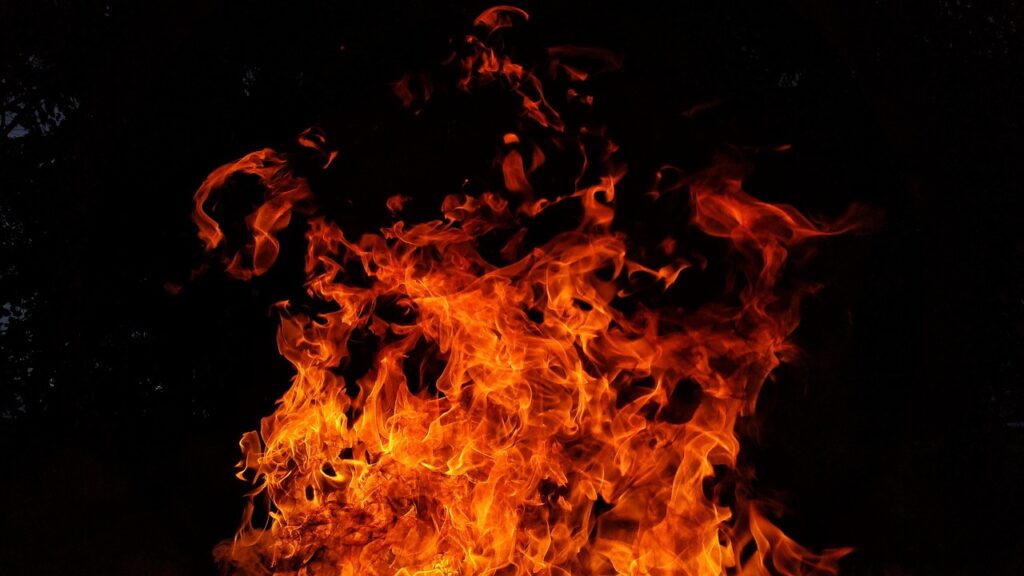Not many materials can withstand the devastating nature of fire. But what about metal garages?
Constructed primarily from steel or aluminum, metal garages are often perceived as more fire resistant than their wooden counterparts.
Still, the question arises: can a metal garage collapse from fire? While metal is noncombustible, it is not impervious to the effects of high temperatures. Understanding the behavior of metal structures under fire conditions is crucial for homeowners, builders, and emergency responders alike.
The Nature of Metal in Fire
Steel and aluminum are the primary materials used in metal garages across the United States. These metals are noncombustible, which makes them inherently more resistant to fire compared to wood or plastic. Steel has a melting point of about 2500 degrees Fahrenheit, while aluminum melts at approximately 1220 degrees Fahrenheit. Although these melting points are well above the average temperatures reached in most residential fires, prolonged exposure to extreme heat can still cause these materials to lose their structural strength long before reaching their melting thresholds.
As steel and aluminum are heated, their molecular structures begin to weaken, leading to a significant reduction in load-bearing capacity. Research by the Metal Building Manufacturers Association shows that unprotected steel can lose up to half of its strength when temperatures approach 1100 degrees Fahrenheit. At this stage, the metal does not need to melt to become a safety concern. As the material becomes less rigid and begins to deform, the structural integrity of the building can be severely compromised. This weakening is especially dangerous if the building is under additional loads, such as a vehicle or stored equipment inside the garage.
The behavior of metal in a fire is not determined by temperature alone. Other factors such as fire duration, external loads, and the presence or absence of protective coatings all play a significant role. For example, if the fire is localized but intense, the heat may affect specific structural components disproportionately, causing uneven stress and eventual failure. Studies conducted by the National Institute of Standards and Technology have confirmed that steel-framed buildings can undergo severe deformation under fire conditions. Without adequate fire protection such as insulation or specialized coatings, these structures are vulnerable to collapse even in a fire that is relatively short in duration.
Case Studies of Metal Structure Collapses
Metal structures are often assumed to be safer than traditional wood buildings when it comes to fire resistance. While they are generally more fire-resistant, they are not immune to collapse when exposed to intense heat over time. A well-known example is the collapse of a Kmart warehouse where the structural frame, primarily made of steel, failed under the stress of a large fire. As the temperature rose, the steel members began to weaken, eventually giving way and causing the roof and walls to fall inward. The fire’s intensity made it difficult for firefighting crews to reach the core of the blaze, which was shielded by the collapsed structure.
This event served as a stark reminder that fire resistance does not mean fireproof. In many cases, buildings that meet all current safety standards can still fail if exposed to extreme conditions that exceed design expectations. The Kmart incident underscored the importance of evaluating not only the materials used but also the way the building is designed and maintained. When the structure failed, it not only resulted in a total loss of the building but also placed firefighters at significant risk during response efforts.
A more complex and historically significant case is the collapse of 7 World Trade Center on September 11, 2001. Unlike the Twin Towers, this building was not struck by an airplane. However, it was damaged by debris and fires from the earlier collapses. The uncontrolled fires inside the building eventually led to the failure of a critical column. Once that column gave way, the structure collapsed progressively from the inside out. This was the first time a tall steel-framed building was known to collapse solely due to fire, and it became a key point of study for engineers seeking to understand fire’s impact on metal buildings.
Fire Load in Garages
Metal garages are frequently used to store more than just vehicles. Many homeowners also keep flammable liquids such as gasoline, oil, and paint inside these buildings. Each of these items increases the fire load, which refers to the total potential energy that can be released in a fire. In addition to liquid fuels, garages often house rags, cardboard boxes, tools with plastic components, and other items that are easily combustible. All of these can contribute to a rapid temperature increase once a fire starts.
Vehicles parked inside a metal garage can also be a significant source of fuel in the event of a fire. The gasoline in the fuel tank, rubber tires, and plastic interiors are all highly flammable. A vehicle fire can escalate very quickly, reaching temperatures that may challenge the structural limits of even a steel or aluminum garage. According to Fire Engineering experts, such fires can produce sustained heat levels that reduce the load-bearing capacity of metal components, particularly in enclosed spaces with limited ventilation.
The way items are arranged within the garage can also influence how a fire behaves. When materials are stacked close together, airflow is restricted, which can lead to more intense and longer-lasting fires. Poor ventilation allows heat to build up and become trapped, accelerating the weakening of metal components. Organized storage, regular cleaning, and limiting the number of flammable items can help reduce these risks. Garages that are cluttered or poorly maintained present an even greater danger in a fire scenario because the fire has more fuel and fewer escape paths for heat and smoke.
Building Codes and Fire Protection Measures
Building codes in the United States are designed to protect lives and property through the regulation of construction practices. For metal garages, these codes include specific provisions related to fire safety. The International Building Code, along with standards from the Metal Building Manufacturers Association, outlines how metal structures should be constructed to meet one-hour and two-hour fire resistance ratings. These time-based ratings indicate how long a building component can withstand direct fire exposure before it is expected to fail.
To meet these requirements, builders often use specialized fire-resistant materials. This may include applying fire-resistant coatings to the metal surfaces or using fire-rated panels in the walls and ceilings. Such coatings can delay the rate at which heat is absorbed by the metal, allowing more time for evacuation and fire suppression. Some fire protection systems also include the use of gypsum board and other passive fireproofing materials that create a barrier between the heat and the structural frame. These systems are tested under controlled conditions to ensure they perform effectively under real fire scenarios.
Active fire protection systems are also encouraged, particularly in garages that serve commercial or multifamily residential buildings. Sprinkler systems and smoke detectors are among the most common installations. These systems can detect and suppress fires early, minimizing the risk that the structure will become exposed to dangerous levels of heat. Incorporating such systems not only enhances safety but may also be required to comply with local building codes. As building technologies evolve, newer methods of protecting metal buildings are being developed and integrated into modern construction practices.
Importance of Fire-Resistant Design
Planning a fire-resistant metal garage starts long before construction begins. Architects and engineers must select materials that offer both structural integrity and adequate resistance to heat. This includes choosing thicker gauge steel, incorporating fire-retardant insulation, and avoiding design features that could act as heat traps. The layout of the building, including the placement of windows and vents, can also influence how well it will perform under fire conditions. A well-ventilated space can reduce the buildup of extreme heat, delaying the point at which structural damage begins to occur.
The installation of fire detection and suppression systems is another key part of a fire-resistant design. Early warning devices such as smoke detectors provide critical time for occupants to escape, while sprinkler systems can reduce the fire’s intensity before it reaches structural elements. These systems are particularly important in garages that are attached to homes or that contain flammable materials. Installing them may involve additional upfront costs, but they can ultimately save lives and protect valuable property.
Even the best-designed structures require ongoing attention to ensure they remain safe. Over time, protective coatings can deteriorate, insulation may degrade, and systems like sprinklers and detectors can fail without regular testing. Routine inspections should be scheduled to check for these potential issues. Prompt repairs and updates based on these inspections help preserve the building’s fire resistance. Maintenance is not just about extending the life of the structure; it is a critical component of ensuring that the metal garage will not collapse in the event of a fire.
Conclusion
While metal garages offer numerous advantages, including durability and fire resistance, they are not immune to the effects of intense fires. Under certain conditions, such as prolonged exposure to high temperatures and the presence of significant fire loads, metal structures can weaken and potentially collapse. Adhering to building codes, implementing fire protection measures, and maintaining the structure can significantly reduce these risks. Understanding the behavior of metal in fire scenarios is essential for ensuring the safety and longevity of metal garages.

